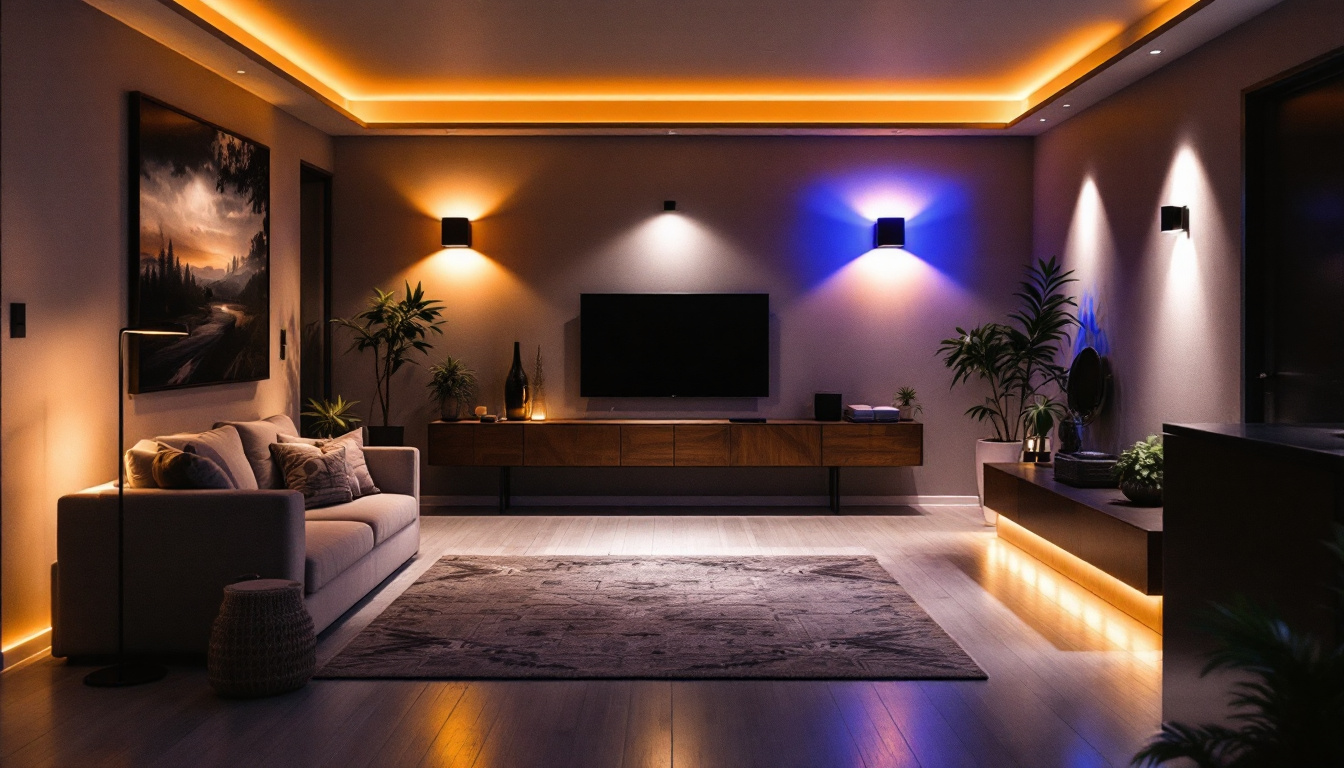
As the demand for energy-efficient lighting continues to rise, LED lights have become a popular choice for various applications, including basements. For lighting contractors, understanding the latest trends in LED lighting for basements is essential to meet client needs and stay competitive in the market. This article explores key trends, design considerations, and installation tips that every lighting contractor should be aware of when working with LED lights in basement spaces.
LED lights offer numerous advantages that make them particularly suitable for basement environments. Their energy efficiency, longevity, and versatility are just a few reasons why they have gained traction among homeowners and contractors alike.
One of the most significant benefits of LED lighting is its energy efficiency. LED bulbs consume significantly less electricity than traditional incandescent or fluorescent bulbs, leading to lower energy bills for homeowners. This is especially important in basements, where lighting is often needed for extended periods. By recommending LED solutions, contractors can help clients save money while also reducing their carbon footprint. Furthermore, many utility companies offer rebates or incentives for switching to energy-efficient lighting, which can further enhance the financial benefits of making the switch to LEDs.
LED lights have an impressive lifespan, often lasting up to 25,000 hours or more. This longevity means less frequent replacements, which translates to lower maintenance costs for homeowners. For lighting contractors, this is a selling point that can enhance client satisfaction and reduce the hassle of follow-up service calls. Additionally, LEDs are built to withstand harsher conditions, making them ideal for basements that may experience fluctuations in temperature and humidity. This durability ensures that homeowners can enjoy consistent lighting without the worry of frequent burnout or replacement.
LED lights come in various shapes, sizes, and color temperatures, allowing for creative flexibility in basement designs. Whether a client desires bright, white lighting for a workshop or warm, ambient lighting for a cozy family room, LED options can accommodate diverse preferences. This versatility enables contractors to tailor solutions that align with the specific needs and aesthetics of each basement project. Additionally, the ability to dim LED lights or adjust their color temperature can create dynamic atmospheres, making it easy to transition from a functional workspace to a relaxing entertainment area. With smart LED technology, homeowners can even control their lighting remotely, adding an extra layer of convenience and modernity to their basement spaces.
As technology evolves, so do the trends in LED lighting. Staying informed about the latest developments can help lighting contractors offer cutting-edge solutions that appeal to modern homeowners.
smart lighting technology is becoming increasingly popular in residential settings, including basements. Homeowners are looking for ways to control their lighting remotely, adjust brightness levels, and even change color temperatures through smartphone apps or voice-activated devices. Lighting contractors should be familiar with smart LED options and how to integrate them into basement designs. This not only adds convenience for the homeowner but also enhances the overall appeal of the space.
Layered lighting is a design trend that emphasizes the use of multiple light sources to create a well-lit and inviting atmosphere. In basements, this can include a combination of ambient, task, and accent lighting. Contractors should consider installing recessed LED lights for general illumination, along with pendant lights or wall sconces for added character. This approach not only enhances functionality but also contributes to the overall aesthetic of the basement.
Homeowners are increasingly interested in customizing the color temperature of their lighting to suit different activities and moods. Cooler temperatures (5000K and above) are often preferred for workspaces, while warmer temperatures (2700K to 3000K) create a cozy atmosphere for relaxation areas. Contractors should be prepared to discuss these options with clients and recommend LED fixtures that allow for easy adjustment of color temperatures.
When designing lighting solutions for basements, several factors must be taken into account to ensure optimal functionality and aesthetics.
Basements often have lower ceilings compared to other areas of the home, which can impact lighting choices. Recessed lighting can be an excellent solution for low ceilings, as it provides illumination without taking up valuable vertical space. Additionally, contractors should consider the layout of the basement when planning lighting placement. Areas such as staircases, corners, and alcoves may require additional attention to ensure even distribution of light.
Basements are prone to moisture and humidity, which can affect lighting fixtures. It is crucial to select LED lights that are rated for damp or wet locations to prevent damage and ensure safety. Contractors should also consider using fixtures with sealed enclosures to protect against moisture infiltration.
Lighting contractors must stay informed about local energy codes and regulations that may impact basement lighting installations. Many regions have specific requirements for energy efficiency and safety standards. Ensuring compliance not only protects the contractor but also enhances the homeowner’s confidence in the installation.
Proper installation is key to maximizing the benefits of LED lighting in basements. Here are some essential tips for lighting contractors to consider.
Before installation, it is vital to plan the lighting layout carefully. Contractors should take measurements of the space and identify key areas that require illumination. Creating a lighting plan can help visualize the placement of fixtures and ensure that all areas are adequately lit. This step is particularly important in basements, where shadows can create safety hazards.
Incorporating dimmer switches into the lighting design can provide homeowners with greater control over their basement lighting. Dimmers allow users to adjust brightness levels according to different activities, whether it’s hosting a gathering or enjoying a quiet evening. This flexibility enhances the overall experience and makes the basement a more versatile space.
Once the LED lights are installed, it is essential to test the lighting to ensure it meets the desired effect. Contractors should check for any dark spots or overly bright areas and make adjustments as needed. This may involve repositioning fixtures or changing the wattage of bulbs. Taking the time to fine-tune the lighting can significantly improve the functionality and appeal of the basement.
With a wide array of LED products available, contractors can choose from various options to suit different basement needs. Here are some popular choices that are gaining traction in the market.
Recessed LED lights are a staple in modern basement designs. They provide a sleek, unobtrusive lighting solution that works well in low-ceiling spaces. Available in various sizes and color temperatures, these fixtures can be strategically placed to create a balanced and inviting atmosphere.
LED strip lights are increasingly popular for adding accent lighting in basements. They can be installed along shelves, under cabinets, or around architectural features to create a warm glow. These flexible strips are available in various colors and can be cut to fit specific lengths, making them a versatile choice for creative lighting designs.
For areas where recessed lighting is not feasible, surface-mounted LED fixtures offer an excellent alternative. These fixtures come in various styles, from sleek and modern to more traditional designs, allowing contractors to match the aesthetic of the basement. They provide ample illumination while also serving as decorative elements.
The landscape of LED lighting is continually evolving, and contractors should keep an eye on emerging trends that could shape the future of basement lighting solutions.
As smart home technology advances, the integration of LED lighting with home automation systems is becoming more prevalent. Homeowners are looking for seamless ways to control their lighting through centralized systems, allowing for enhanced convenience and energy management. Contractors should familiarize themselves with these systems to offer comprehensive lighting solutions that align with the growing trend of smart homes.
With increasing awareness of environmental issues, sustainable lighting solutions are gaining attention. This includes the use of eco-friendly materials in fixtures and the promotion of energy-efficient practices. Contractors can position themselves as leaders in sustainable lighting by recommending products that prioritize environmental responsibility.
As LED technology continues to advance, new products and features will emerge. This includes improvements in color rendering, dimming capabilities, and energy efficiency. Staying informed about these advancements will enable contractors to provide the best possible solutions for their clients, ensuring satisfaction and loyalty.
LED lights are revolutionizing basement lighting, offering energy efficiency, versatility, and design flexibility. By staying informed about current trends, design considerations, and installation techniques, lighting contractors can provide exceptional service and innovative solutions to their clients. As the industry continues to evolve, embracing new technologies and sustainable practices will be key to remaining competitive and meeting the ever-changing demands of homeowners.
Incorporating these insights into basement lighting projects will not only enhance the functionality and aesthetics of the space but also contribute to the overall satisfaction of clients. As the popularity of LED lighting grows, contractors who adapt to these trends will find themselves well-positioned for success in the dynamic world of lighting design.
Ready to elevate your basement lighting projects with the latest LED trends? Look no further than LumenWholesale for all your lighting needs. Our extensive selection of spec-grade lighting products ensures you have access to high-quality, energy-efficient solutions at unbeatable wholesale prices. Say goodbye to local distributor markups and hello to hassle-free bulk buying with free shipping. Don’t compromise on quality or value; choose LumenWholesale for the perfect blend of affordability and convenience. Start transforming your lighting projects today by visiting Wholesale Lighting at the Best Value.

Discover the key differences between T8 and T12 fluorescent tubes and why these distinctions matter for lighting contractors.

Discover the essential facts about solar pathway lights outdoor that every lighting contractor should know.

Discover the transformative power of landscaping spotlights with essential insights from lighting contractors.

Discover innovative strategies from top lighting contractors for installing 4-inch LED recessed lights.